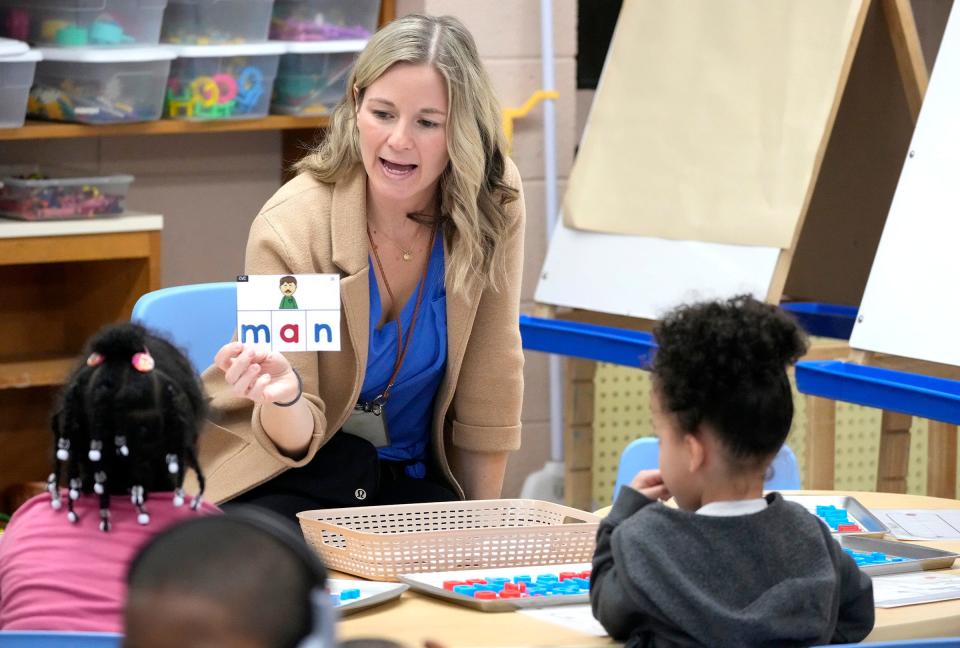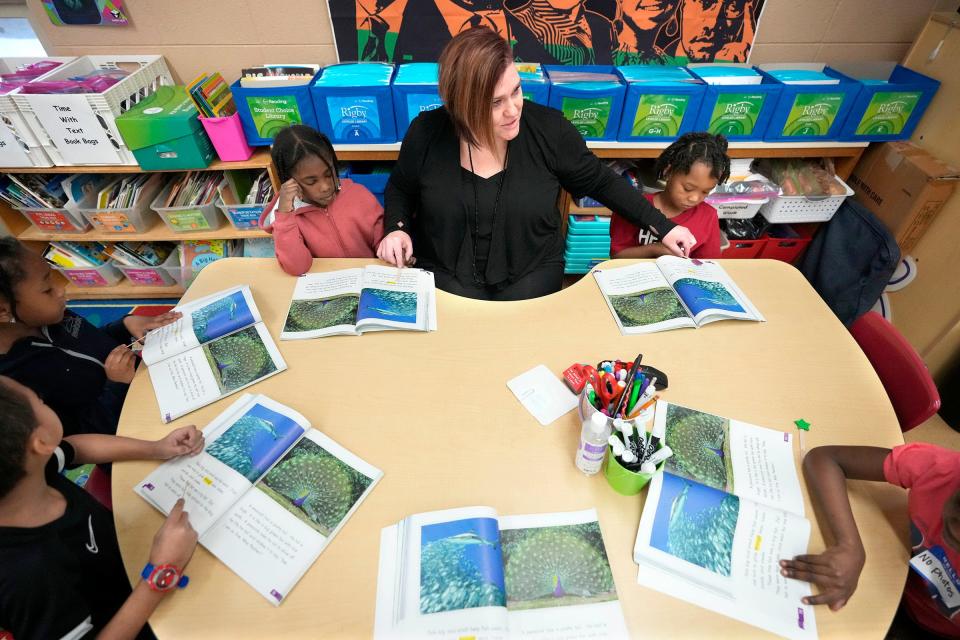Can efforts to improve reading for Milwaukee students be successful this time? MPS superintendent says yes
This is the second of two stories on issues focusing on teaching Milwaukee students to read. This is part of the By the Book series, which examines reading curriculum, instructional methods and solutions in K-12 education to answer the questions: Why do so many Wisconsin kids struggle to read? And what can be done about it?
More: The state capital of reading problems, Milwaukee Public Schools looks at how to turn things around
Why hasn’t the needle moved?
The history of efforts to teach reading successfully in Milwaukee is not pretty. The key fact is that reading scores have been stagnant and poor for more than two decades, despite reform attempts and proclamations over the years that things were going to improve (this time for sure!).
Several examples:
In 2008, MPS brought in a group of nationally known reading educators to analyze what the system was doing. Their report was highly critical. It said MPS schools used an array of curriculums that often were not carried out well, with little effective oversight from district leaders. The report called for major changes. “The status quo will need to be changed, sometimes dramatically,” it said. “Currently, in MPS, there seems to be little reason to expect struggling students to ever catch up with their achieving peers.”
The net result: Sure enough, there continued to be little reason to expect students to catch up.
More: By the Book: We're investigating why many Wisconsin kids struggle to read. We want to hear from you.
In January 2012, then-Gov. Scott Walker created and chaired a statewide “Read to Lead” task force. The vice chair was Tony Evers, then the state superintendent of public instruction and now the governor. The task force recommendations included creating a statewide requirement that anyone seeking to teach reading get training in how to do that. They then had to pass a test called the Foundations of Reading assessment. Those steps were approved, but more than a decade later, reading scores have not improved.

Then there are examples of programs that have shown positive results, such as the Wisconsin Reading Corps, which puts generally young adults in one-year public service jobs tutoring students in schools around the state. A good idea, but simply not large enough to have broad impact. The same with various other in-school and after-school programs involving nonprofit organizations — programs some of which have come and gone.
If things weren’t good before 2020, the COVID pandemic generally made them worse. Especially among low-income kids, large numbers of whom were out of school for extended periods, whatever incremental progress had been made in some places was erased by the time schools got back to more normal schedules.
In results of the National Assessment of Educational Progress, Wisconsin’s ranking for reading success, compared to other states, has slipped gradually for more than 20 years. In short, Wisconsin’s scores have stayed generally flat while scores in some other states have improved.
NAEP has a voluntary program for large urban districts to assess fourth- and eighth-grade students. MPS is among 26 districts that took part in the most recent round of testing, with results released in 2022. The overall reading scores for MPS fourth-graders were lower than in 2009 and sharply lower than that of students in urban districts nationwide.
NAEP classified the Milwaukee fourth-grade scores as lower than 22 of the other large districts, not significantly different than one district (Baltimore City), and better than two districts (Detroit and Cleveland).
For eighth-graders, reading scores of Milwaukee students had not changed significantly in more than a decade and were well below the national average for urban students. MPS scores were lower than 18 districts and not significantly different than six districts (Baltimore City, Cleveland, Dallas, Fort Worth, Philadelphia, and Shelby County (Memphis), Tennessee). Milwaukee scores were higher than only Detroit.
There is not comparable information available for nationwide comparisons of success in reading for students in private or charter schools. But the overall results in Milwaukee are not much better in those schools than in MPS schools.
So what would it take to increase the number of Milwaukee students who become good readers?
Going beyond 'word calling' to comprehension
Tanya Evans, the MPS reading curriculum specialist, said more professional development of teachers is one need, along with more small-group work with students.
She expressed concern about the way some school systems and entire states are embracing the phonics-heavy approach of what is often called the science of reading. There’s more to learning reading than phonics, she said.
“We’re taking it to the extremes” in some places, she said. She said there are students who read beautifully when it comes to pronouncing words but “who can’t tell you what they read.” A frequent criticism of the science of reading is that students don’t develop enough skills in comprehending what they read.
Evans said teachers need to get kids to think about what they’re reading and to question things. We don’t just want “word callers,” she said.
Science of reading advocates reject those criticisms and say that, when taught well, kids learn to understand what they’re reading and learn to love to read.
MPS Superintendent Keith Posley said the school system is improving the ways reading is taught, but there needs to be more emphasis on using “best practices.”

MPS had a corps of reading coaches helping schools generally in the 2000-10 period. Anecdotal evidence from that period suggested that results were good in some schools and not of much consequence in others, which may well have related to the quality of individual coaches’ work. Amid financial pressures and changes in priorities, the coaching effort declined.
Now Gov. Evers and Jill Underly, state superintendent of schools, have proposed state funding for reading coaches in some schools across Wisconsin. The prospects for that being included in the state budget under current consideration appear better than the prospects for other proposals from Evers and Underly. Posley said he was looking to Madison for funding of reading coaches in MPS.
Posley said that, overall, MPS needs to “stay the course” it is on in teaching reading. It takes time to achieve improved results, but it can be done, he said.
But how much can a school accomplish, given the things kids experience outside of school?
Posley says schools can overcome outside influences that affect kids
Posley said schools can overcome the outside factors affecting children. “I’m a prime example,” said Posley, who grew up in the South. “I could check all of these boxes” of childhood circumstances that can adversely affect kids’ education. “But I had individuals who didn’t give up on me.”
MPS, he said, has resources, including not only teachers but also social workers, psychologists and others to help students succeed in school.
But consider an anecdote from the recent annual convention of the Wisconsin State Reading Association, a large organization of reading educators that has generally been critical of the science of reading approach.
For one session at the convention, I sat next to two MPS teachers. During the presentation, the speaker lambasted science of reading advocates, whom he called “anti-teacher.” He said the key to improving reading success was doing something about the forces impeding children’s success, such as inadequate health care.
After the session, I asked the two teachers what they thought and how things were going at their school. They said they were dedicated to their kids and school, but they described large classes that included significant numbers of students who were disruptive. It was hard to focus on instruction. Their descriptions were in line with what I have heard from many teachers.
Issues with students who aren't really engaged with their schooling and with high rates of absenteeism make success hard to achieve in many Milwaukee classrooms.
There are sobering questions about what teachers can accomplish and how likely students are to do well in the circumstances in their classrooms, no matter what approach to teaching is used. And you can’t teach kids who aren’t there.
Posley acknowledged that there are difficulties with finding teachers who are well-trained to teach reading, as well as with keeping them in MPS. Teachers were plentiful in the past, he said. Not so now. MPS had several hundred teaching vacancies throughout the current school year, and many who are teaching have emergency licenses from the state Department of Public Instruction because they have not (or have not yet) qualified for full teaching licenses.
Adding to the problems: Teacher vacancies are greater in high-needs schools than in schools where student performance is better, according to a recent report from the Milwaukee School Board’s accountability specialist, Matthew Chason.
“We’ve got to bring that love of teaching back,” Posley said.
Still, challenges to readers are pervasive
Even as it moves to change how it teaches reading, MPS has not embraced the phonics-oriented science of reading approach in the same structured, comprehensive way as some other school districts, such as New Berlin and Cudahy.
There are signs of progress and some brighter spots.
But consider the whole picture: the life circumstances of the students, the broad cultural forces that challenge teachers and others who work in schools, the limits on resources, the difficulty changing practices in a big and bureaucratic system, the problems of sustaining consistent efforts in circumstances of limited stability.
Then add in the efforts to improve the curriculum and teaching methods teachers use for the complex job of leading children to become good readers.
Advocates for the science of reading see improving curriculum and methods as valuable and necessary steps. Nationwide, there is momentum growing to adopt such approaches and there are signs of positive momentum in some places.
More: A bipartisan consensus could be growing on how to teach reading statewide
Even if they are right, improving the way reading is taught in the most challenging locales would almost surely be only one step in a long journey to educational success.
Alan J. Borsuk is senior fellow in law and public policy at Marquette Law School. Reach him at alan.borsuk@marquette.edu.
Our subscribers make this reporting possible. Please consider supporting local journalism by subscribing to the Journal Sentinel at jsonline.com/deal.
DOWNLOAD THE APP: Get the latest news, sports and more
This article originally appeared on Milwaukee Journal Sentinel: Teaching MPS kids to read comes with plenty of challenges

